| Surfaces Let C be a curve, then we define a cylinder to be the set of all lines through C and perpendicular to the plane that C lies in. 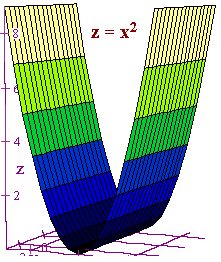 We can tell that an equation is a cylinder is it is missing one of the variables. Quadric Surfaces Recall that the quadrics or conics are lines , hyperbolas, parabolas, circles, and ellipses. In three dimensions, we can combine any two of these and make a quadric surface. For example
Surface of Revolution Let y = f(x) be a curve, then the equation of the surface of revolution abut the x-axis is 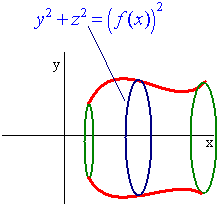 y2 + z2 = f(x)2 Example Find the equation of the surface that is formed when the curve y = sin x 0 < x < p/2 is revolved around the y-axis. Solution This uses a different formula since this time the curve is revolved around the y-axis. The circular cross section has radius sin-1 y 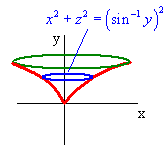 and the circle is perpendicular to the y-axis. Hence the equation is and the circle is perpendicular to the y-axis. Hence the equation is x2 + z2 = (sin-1 y)2 Cylindrical Coordinates We can extend polar coordinates to three dimensions by
Example We can write (1,1,3) in cylindrical coordinates. We find and so that the cylindrical coordinates are ( called spherical coordinates. We let r denote the 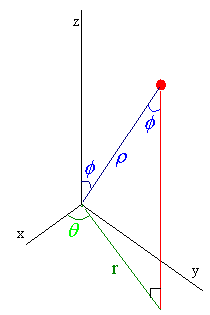 distance from the point to the origin, q represent the same q as in cylindrical coordinates, and f denote the angle from the positive z-axis to the point. The picture tells us that distance from the point to the origin, q represent the same q as in cylindrical coordinates, and f denote the angle from the positive z-axis to the point. The picture tells us that r = r sin f and that z = r cos f From this we can find
Immediately we see that x2 + y2 + z2 = r2 We use spherical coordinates whenever the problem involves a distance from a source. convert the surface z = x2 + y2 to an equation in spherical coordinates. Solution We add z2 to both sides z + z2 = x2 + y2 + z2 Now it is easier to convert r cos f + r2 cos2 f = r2 Divide by r to get cos f + r cos2 f = r Now solve for r. cos f cos f r = 1 - cos2 f sin2 f |
| |
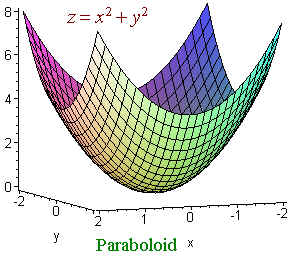
No comments:
Post a Comment